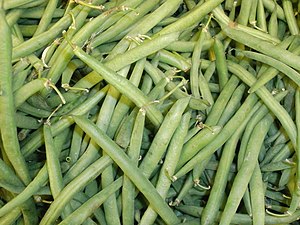
Green beans (also called French beans or Runner beans in British English) are the young, unripe form of any kind of bean. They are nutritious and easy to grow, and like all beans they add nitrogen to the soil, enriching it.
The pods of the common beanW (Phaseolus vulgaris) are usually called string beans or snap beans.
Green bean varieties have been bred for the fleshiness, flavor, or sweetness of their pods. Haricots verts, French for "green beans," may refer to a longer, thinner type of green bean than typical green beans.
Culinary Use[edit | edit source]
Green beans are grown and eaten around the world.
It is good to pick young, tender green beans.
They are often steamed, stir-fried, or baked in casseroles. A simple way to prepare them is to saute over high heat on top of the stove with just a drop of oil or butter for a couple of minutes. Add a little water if it gets too dry. Optionally: your choice of herbs or spices can be added while cooking; or splash a little soy sauce over them right before they are served.
Mildly toxic when raw[edit | edit source]
Although it is common for green beans to be eaten raw in salads or straight from the garden, green beans are actually mildly toxic when raw.[1] They contain the same toxins and anti-nutrients as mature and dried beans, but in lower concentrations.
This is not a cause for major alarm (almost every food has "toxins" in it, and some actually have beneficial effects). Clearly they're not highly toxic as they're often eaten raw with no noticeable effects. Just be aware and take the following precautions:
- If you pick raw beans to eat, the younger you pick them and the smaller the actual seed, the less of the harmful compounds there will be. The concentration of toxins is lower in the fleshy pods than in the actual seed.[verification needed]
- Limit the amount of raw beans you eat: Picking a few beans from your garden or putting a few in a salad is probably fine, but don't make them the staple of a raw food diet, and don't drink large quantities of beans in a green smoothieW every morning.
- Boiling at 100 deg C for 10 minutes is adequate to destroy these compounds in dried beans; cooking for a shorter time may be adequate in green beans.[verification needed] (What is the impact of blanching, or cooking for just 1-2 minutes?[expansion needed])
Cultivation[edit | edit source]
Green beans are found in two major groups, bush beans and pole beans.
Bush beans are short plants, growing to approximately 60 cm (2 ft) in height, without requiring supports. They generally reach maturity and produce all of their fruit in a relatively short period of time, then cease to produce. Gardeners may grow more than one crop of bush beans in a season.
Varieties[edit | edit source]
Over 130 varieties of snap bean are known.[2] Varieties specialized for use as green beans, selected for the succulence and flavor of their pods, are the ones usually grown in the home vegetable garden, and many varieties exist. Pod color can be green, golden, purple, red, or streaked. Shapes range from thin "fillet" types to wide "romano" types and more common types in between. French Haricots verts (green beans) are bred for flavorful pods.
"Yard long beans" are available in many oriental markets, cooked similarly, though they may not come out more than a foot (30 cm) long.
The following varieties are among the most common and widely grown.
Bush types[edit | edit source]
- Burpee's Stringless Green Pod, 50 days (green, heirloomW)
- Contender, 50 days (green)
- Rocdor, 53 days (yellow)
- Cherokee Wax, 55 days (yellow), 1948 AASW winner
- Golden Wax/Improved Golden Wax/Pencil Pod Black Wax/Top Notch, 55 days (yellow, heirloom)
- Red Swan, 55 days (red)
- Blue Lake 274, 58 days (green)
- Maxibel, 59 days (green fillet)
- Roma II, 59 days (green romano)
- Improved Commodore/Bush Kentucky Wonder, 60 days (green), 1945 AAS winner
- Dragon's Tongue, 60 days (streaked)
Pole types[edit | edit source]
- Marvel of Venice, 54 days (yellow romano)
- Blue Lake, 60 days (green)
- Fortex, 60 days (green fillet)
- Kentucky Blue, 63 days (green), 1991 AAS winner
- Old Homestead/Kentucky Wonder, 65 days (green, heirloom)
- Rattlesnake, 73 days (streaked, heirloom)
- Purple King, 75 days (purple)
References[edit | edit source]
- ↑ rawfoodinfo.com, Hong Kong government info. Note also the warning on Thompson & Morgan's Dwarf Bean seeds page: "NEVER EAT PODS RAW." Note also the conclusion by one writer: "I can find no clear evidence that raw green beans have PHA levels high enough to make them unsafe for most of the population. It should be noted that the level of PHA is highest in seeds, and green beans are usually consumed for the sake of the green fleshy pod, at a stage when the seeds are only beginning to develop."
- ↑ Facciola, Stephen (1998). Cornucopia II: a source book of edible plants. Kampong Publications. ISBN 0962808725.
See also[edit | edit source]
- Vegetables